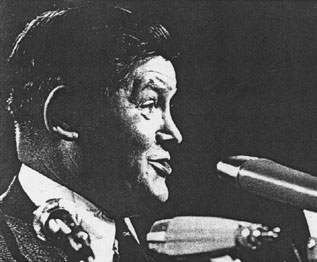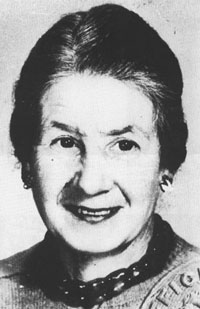|
Unrepresented
Nations and Peoples Organisation
International
Celtic Congress
Celtic
Lanquages
Celtic
Leaque
Breizh/Brittany
Kernow/Cornwall
Alba/Scotland
Wales/Cymru
Y
Faner Goch
Eire/Ireland
Mannin/Isle
of Man
Galicia/Galiza
|

"There
are many who claim William was killed by 'them' - the
same 'them' that killed Hilda Murrell (the antinuclear
campaigner murdered in 1984") Michael Strathan,
friend of William McRae, quoted in the News on Sunday,
5th November 1987.
On the morning of April 6th
1985, a radical Scottish Nationalist lawyer, and former
Vice-Chairman of the SNP (Scottish National Party) William
McRae, was found shot in his car at a layby on the A87,
north of An Gearasdan (Fort William), in the Highlands of
Scotland. He was found slumped in a coma in the driving
seat, the ignition key on his lap. It initially looked like
the car had been in some kind of motor accident - his maroon
blue Volvo was found lying across a stream, with the drivers
window wound down, and the door jammed in such a manner,
that it hardly open. McRae was barely alive. A member of the
public called an ambulance, and he was taken to Aberdeen
Royal Infirmary, where he died the next day.
His personal papers and
documents were some distance from the car and they had all
been shredded "fairly meticulously" according to a report in
the Celtic magazine Carn. (1) None of the witnesses
saw a pistol or any cartridges near the vicinity of the car
- although the police would later claim he had shot himself
in the head. Police later recovered a revolver (owned by
McRae), some distance from the car. Not only had some of his
papers been found some 20 ft from the car, bizarrely, his
watch was also found, with it's face smashed. Little or no
explanation was given about how, after supposedly shooting
himself, McRae had managed to throw his gun some distance
from the car. As for his two briefcases, these were
eventually returned to his brother by the police, who were
unable or unwilling to reveal exactly where they were found.
According to eyewitnesses who discovered McRae, their were
no briefcases at the scene, or in the vehicle.
However, the bullet wound in
the back of his head was only discovered when his body was
being examined at a hospital in Aberdeen, Scotland. In fact.
two years after his death, Hamish Watt, a former SNP MP and
Councillor in Grampian told the Aberdeen Press &
Journal that a nurse working at Aberdeen Royal
Infirmary, where McRae was admitted, told him him that
two bullet wounds were found in his brain - a fact
that would clearly rule out suicide.
According to a report in The
Sunday Mail, (2) it was found that McRae had been shot
by an automatic pistol which had been fired twice at
pointblank range. The window of his car had been shattered -
possibly by a bullet. McRae's gun was "discovered" by the by
the police two days after his death.
McRae had also told friends
before his death that he believed he was under Special
Branch surveillance, and that he was in danger as his "cover
was blown" and because he was on a "hit list". McRae had
also been a leading member of Siol nan Gaidheal, a
direct action group once connected with SNP members - some
of whom had been detained under the Prevention of Terrorism
Act (PTA) and had been given legal advice by McRae.
Furthermore, a small Scottish guerrilla group, the Scottish
National Liberation Army (SNLA), claimed in their
clandestine newspaper Saorsa that McRae had been an
"active sympathiser" who had assisted them both financially,
and in the planning of attacks. Perhaps it was his
involvement in this that had been exposed when he talked of
his "cover" being blown?

Hilda Murrell, the
antinuclear campaigner murdered in 1984
Like the 79 year-old
antinuclear campaigner (and famous rose-grower) Hilda
Murrell, McRae was also passionately opposed to the dumping
of nuclear and other toxic waste. Gary Murray, in his book
Enemies of the State: A Sensational Exposé of the
Security Services by a former MI5 Undercover Agent,
describes McRae as the "most formidable opponent in
Scotland" of the Nuclear industry. One of his most famous
quotes was from the Mullwharcher Enquiry in 1980, which
overturned plans for nuclear dumping in the Ayrshire hills.
"Nuclear waste" McRae said, "should be stored where Guy
Fawkes put his gunpowder" (3). At the time of his death,
McRae was planning to take part in a public Enquiry into the
processing of nuclear waste at Dounray, and his law firm was
on the list of official protesters. He was also writing a
book on the subject, and he was known to carry two suitcases
everywhere which contained most of his material for both the
campaign and his book.
According to Murray, on the
after of the same day that McRae was found shot in his car,
a party of walkers a few miles from the site where he was
found reported that during the afternoon of the 6th April
1985, a man drove up the road, parked, got out, and fired a
number of shots in their direction. As Murray notes, his car
(a red escort) was similar to the one spotted at the site of
Hilda Murrell's murder a year earlier (p. 214).
Born in 1923 in Wester Ross,
northern Scotland, William McRae had been from an early age
politically active in the Scottish National Party (SNP).
After serving in the army during the war, he joined the
Royal Indian Navy, where he served in Naval Intelligence. It
was here, that he learned to speak Urdu, and began
addressing public meetings in Scotland. He resumed his
political activities when he joined the Indian National
Congress, then an illegal organisation involved in an
underground war against British colonial rule in India. It
was probably at this point that he came under surveillance
by MI5 and MI6, which would continue until his death in
1985. Shortly before he died, his cottage in Dornie was
burgled and his friend Mary Johnstone maintains that McRae
said:
"They didn't get
what they were looking for" (Murray, p. 213).
Murray speculates on whether
this was a reference to the sensitive documents he always
kept in his briefcase. Another strange thing happened just
before his death, a vehicle with two men in it followed him
to his home. According to Murray, local friends and
investigators traced the number plate of the car to the
Strathclyde Special Branch.
Apart from looking in detail
at the death of McRae, the author Gary Murray, also
investigated the death of Hilda Murrell, and found at least
15 similarities between them. Furthermore, in Murrell's
case, a private investigator linked to MI5, Barrie Peachman,
was also found dead in disputed circumstances. He had been
involved in the surveillance of peace
campaigners.(3)
MURRELL
|
McRAE
|
- Red Escort
observed at scene
- Activities of
interest to M15, Special Branch, Atomic Energy
Police
- About to appear at
public hearing dealing with nuclear
issues
- Passionate
antinuclear campaigner
- Under surveillance
by Security Services
- Witnesses
overlooked by police investigators
- Drove/driven to
death scene in own vehicle
- Death scene: quiet
country spot outside of town
- Victim was said to
have discovered something specific about nuclear
industry
- Authorities
refused Enquiry into death and murder
investigation wound up
- Conflict in
official statements about evidence
- Victim's property
broken into and burned down
- Anomalies
concerning nuclear papers Associates and friends
attempting to pursue the case become victims of
burglary and/or acts of violence or damage to
property
|
- Red Escort
observed at scene
- Activities of
interest to M15, Special Branch, Atomic Energy
Police
- About to appear at
public hearing dealing with nuclear
issues
- Passionate
antinuclear campaigner
- Under surveillance
by Security Services
- Witnesses
overlooked by police investigators
- Drove/driven to
death scene in own vehicle
- Death scene: quiet
country spot outside of town
- Victim was said to
have discovered something specific about nuclear
industry
- Authorities
refused Enquiry into death and murder
investigation wound up
- Conflict in
official statements about evidence
- Victim's property
broken into and an associate's also burgled and
set on fire
- Anomalies
concerning nuclear papers
- Associates and
friends attempting to pursue the case become
victims of burglary and/or acts of violence or
damage to property
|
From: Enemies of the State: A Sensational Exposé
of the Security Services by a former MI5 Undercover
Agent. Gary Murray, Simon and Schuster, London, England,
1993
There is also the evidence of
John Conway, an ex-policeman turned legal rights campaigner
and member of Justice, who investigated the McRae case. He
submitted a report to the Lord Advocate in which he
stated:
"There can be no
doubt that some time after the crash and the first people
arriving on the scene, someone searched through McRae's
pockets and also ransacked the car" (Murray,
p213).
Conway also alleged that a
two-investigation by the police was stopped because of MI5
involvement. In 1991, Conway was run over by a motor bike,
receiving horrendous injuries. He is convinced that this was
a "frightener" that went wrong.
Thus, it is my provisional
conclusion that McRae was unlawfully murdered by a person or
persons unknown, acting on behalf of the the nuclear
industry, and ultimately, the British state. Members of the
new Scottish parliament should call for an Enquiry to be set
up, not only into the covert activities of the nuclear
industry in Scotland, but also to reinvestigate how William
McRae died.
References
1 Carn, Spring 1988. The
SNLA also claimed that another member Douglas Ross
had died in "mysterious circumstances" in 1982. The
group accused "the British state" of McRae's murder, and
Carn speculated that he was killed because of his
association with the SNLA.
2 The Sunday Mail
(Scotland), 16th June 1985.
3 Enemies of the State: A
Sensational Exposé of the Security Services by a
former MI5 Undercover Agent. Gary Murray, Simon and
Schuster, London, England, 1993, p210
© 1997
|

